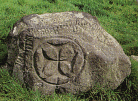

 The Celtic Cross
had it's evolution in the British Isles, with it's earliest form
dating to approximately the ninth century and appearing mostly
in Ireland. This early version is called a recumbent cross-slab,
and they lay flat rather than standing upright. Eventually these
made their way into an upright position (now called erect cross-slabs),
and acquired a slightly rounded top. Both versions were often
decorated with key patterns, interlaced knotwork, and spirals.
The Celtic Cross
had it's evolution in the British Isles, with it's earliest form
dating to approximately the ninth century and appearing mostly
in Ireland. This early version is called a recumbent cross-slab,
and they lay flat rather than standing upright. Eventually these
made their way into an upright position (now called erect cross-slabs),
and acquired a slightly rounded top. Both versions were often
decorated with key patterns, interlaced knotwork, and spirals.
 The cross then
underwent another change. Extraneous rock was carved away from
the head of the slab, leaving the rock with the outlined shape
of a tall cross, usually on a wider base. Because the cross form
was in effect "freed" from the rock now, these types
of crosses were commonly called erect free-standing crosses. From
these, the arms of the cross eventually became extended beyond
the ring of the cross, and the inner quadrants between the rings
and the arms were cut away or recessed from the rest of the cross
design. The free-standing crosses were elaborately made, and often
composed of several pieces of stone. A large cross could have
been made of up to four pieces of stone (the base, the shaft,
the head, and the upper cross arm), held together by mortise and
tenon joints carved into the stone.
The cross then
underwent another change. Extraneous rock was carved away from
the head of the slab, leaving the rock with the outlined shape
of a tall cross, usually on a wider base. Because the cross form
was in effect "freed" from the rock now, these types
of crosses were commonly called erect free-standing crosses. From
these, the arms of the cross eventually became extended beyond
the ring of the cross, and the inner quadrants between the rings
and the arms were cut away or recessed from the rest of the cross
design. The free-standing crosses were elaborately made, and often
composed of several pieces of stone. A large cross could have
been made of up to four pieces of stone (the base, the shaft,
the head, and the upper cross arm), held together by mortise and
tenon joints carved into the stone.
The cross shape itself has been widely used by many ancient peoples, long before the arrival of Christianity. Its four arms were perfect for denoting the four elements, the four directions of the compass, and the four parts of man - mind, body, soul and heart. The addition of the ring around the cross has had many explanations, everything from sun worship and symbolism, to creating a shape with the cross that was well contained and aesthetically pleasing.